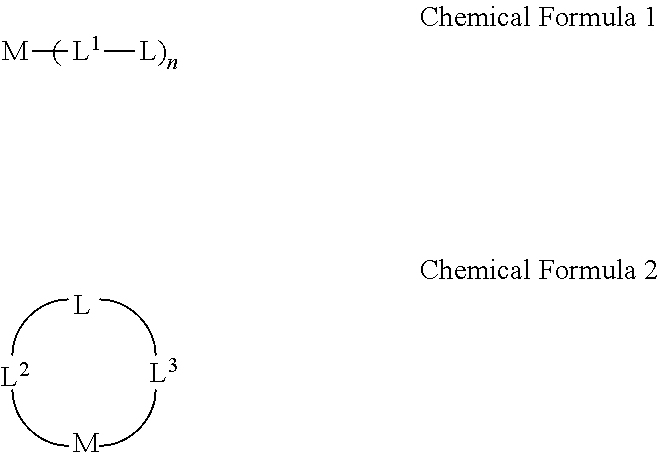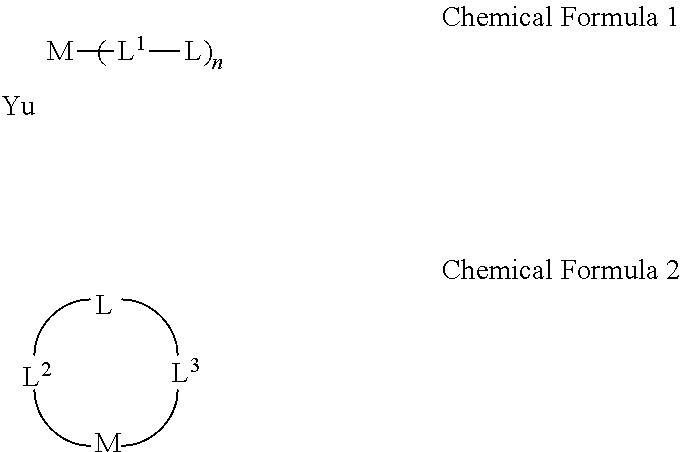Quantum dot, curable composition comprising the same, cured layer using the composition and color filter including the cured layer
a composition and quantum technology, applied in the field of quantum dots, can solve the problems of limited quantum dots dispersion, difficult (e.g., impossible) to increase the photoefficiency of the ink over a certain level, and achieve the effect of improving the photoefficiency of the cured layer, good passivation effect, and easy application
- Summary
- Abstract
- Description
- Claims
- Application Information
AI Technical Summary
Benefits of technology
Problems solved by technology
Method used
Image
Examples
synthesis example 1
[0232]191 g of p-toluenesulfonic chloride and 150 mL of THF were slowly added to a mixed solution of 270 g of polyoxyethylene phenyl ether (PH-4, Hannong Chemicals Inc.), 44 g of NaOH, 500 mL of tetrahydrofuran (THF), and 100 mL of distilled water at 0° C. 30 minutes later after the addition, the obtained mixture was stirred at room temperature (23° C.) for 12 hours. When a reaction was complete, a product therefrom was extracted, neutralized, and concentrated and then, sufficiently dried in a vacuum oven. The dried product was put in a flask and dissolved in ethanol under a nitrogen atmosphere. Then, 4 equivalents of thiourea was added thereto and then, stirred at 100° C. for 12 hours. Subsequently, a diluted NaOH solution was additionally added thereto and then, further stirred for 5 hours. When a reaction was complete, the resultant was washed and extracted with water and a hydrochloric acid diluted solution, neutralized, and then, sufficiently dried in a vacuum oven. 68 g of zin...
synthesis example 2
[0233]191 g of p-toluenesulfonic chloride and 150 mL of THF were slowly added to a mixed solution of 400 g of polyoxyethylene monomethyl ether (MPEG-400, Hannong Chemicals Inc.), 44 g of NaOH, 500 mL of THF, and 100 mL of distilled water at 0° C. 30 minutes later after the addition, the obtained mixture was stirred at room temperature (23° C.) for 12 hours. When a reaction was complete, the resultant was extracted, neutralized, and concentrated and then, sufficiently dried in a vacuum oven. The dried product was put in a flask and then, dissolved in ethanol under a nitrogen atmosphere. Then, 4 equivalents of thiourea was added thereto and then, stirred at 100° C. for 12 hours. A NaOH diluted solution was additionally added thereto and further stirred for 5 hours. When a reaction was complete, the resultant was washed and extracted with water and a hydrochloric acid diluted solution and neutralized and then, sufficiently dried in a vacuum oven. 68 g of zinc chloride was added to the ...
synthesis example 3
[0234]270 g of polyoxyethylene phenyl ether (PH-4, Hannong Chemicals Inc.) and 100 g of succnic anhydride were put together and then, heated up to 100° C. and reacted for 12 hours. The resultant was cooled down to room temperature (23° C.), and 68 g of zinc chloride was added thereto and then, reacted at 80° C. for 12 hours to obtain 435 g of a final product represented by Chemical Formula 1-3.
PUM
| Property | Measurement | Unit |
|---|---|---|
| fluorescence emission wavelength | aaaaa | aaaaa |
| surface tension | aaaaa | aaaaa |
| wavelength region | aaaaa | aaaaa |
Abstract
Description
Claims
Application Information
 Login to View More
Login to View More - R&D
- Intellectual Property
- Life Sciences
- Materials
- Tech Scout
- Unparalleled Data Quality
- Higher Quality Content
- 60% Fewer Hallucinations
Browse by: Latest US Patents, China's latest patents, Technical Efficacy Thesaurus, Application Domain, Technology Topic, Popular Technical Reports.
© 2025 PatSnap. All rights reserved.Legal|Privacy policy|Modern Slavery Act Transparency Statement|Sitemap|About US| Contact US: help@patsnap.com



